Shoot 'em ups are a sub-genre of action games. There is no consensus as to which design elements compose a shoot 'em up; some restrict the definition to games featuring spacecraft and certain types of character movement, while others allow a broader definition including characters on foot and a variety of perspectives.
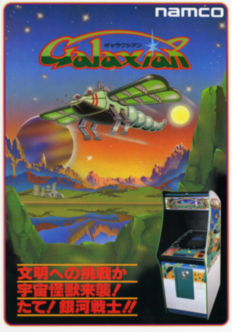
Galaxian is a 1979 fixed shooter arcade video game developed and published by Namco. The player assumes control of the Galaxip starfighter in its mission to protect Earth from waves of aliens. Gameplay involves destroying each formation of aliens, who dive down towards the player in an attempt to hit them.
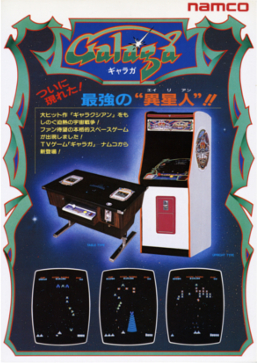
Galaga is a 1981 fixed shooter arcade video game developed and published by Namco. In North America, it was released by Midway Manufacturing. It is the sequel to Galaxian (1979), Namco's first major video game hit in arcades. Controlling a starship, the player is tasked with destroying the Galaga forces in each stage while avoiding enemies and projectiles. Some enemies can capture a player's ship via a tractor beam, which can be rescued to transform the player into a "dual fighter" with additional firepower.

4X is a subgenre of strategy-based computer and board games, and includes both turn-based and real-time strategy titles. The gameplay generally involves building an empire. Emphasis is placed upon economic and technological development, as well as a range of military and non-military routes to supremacy.
In video game parlance, a multicart is a cartridge that contains more than one game. Typically, the separate games are available individually for purchase or were previously available individually. For this reason, collections, anthologies, and compilations are considered multicarts. The desirability of the multicart to consumers is that it provides better value, greater convenience, and more portability than the separate games would provide. The advantage to developers is that it allows two or more smaller games to be sold together for the price of one larger game, and provides an opportunity to repackage and sell older games one more time, often with little or no changes.
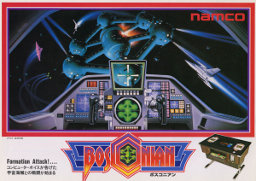
Bosconian is a scrolling multidirectional shooter arcade video game developed and released by Namco in Japan in 1981. In North America, it was manufactured and distributed by Midway Games. The goal is to earn as many points as possible by destroying enemy missiles and bases using a ship which shoots simultaneously both the front and back.
Namco Museum is a series of video game compilations developed and published by Bandai Namco Entertainment for home video game consoles. The first title in the series, Namco Museum Vol. 1, was released for the PlayStation in 1995. Entries in the series have been released for multiple platforms, including the Game Boy Advance, PlayStation 2, PlayStation Portable, Nintendo DS and Xbox 360. the latest being Namco Museum Archives Vol. 2, released in 2020.

Galaga '88 is a 1987 fixed shooter arcade video game developed and published in Japan by Namco and in North America and Europe by Atari Games. It is the third sequel to Galaxian. It features significantly improved graphics over the previous games in the series, including detailed backgrounds, larger enemies and greater ship details. The game runs on Namco System 1 hardware.
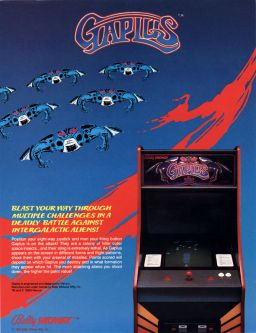
Gaplus is a 1984 fixed shooter arcade game developed and released by Namco. It is the third game in the Galaxian series, serving as a direct sequel to Galaga (1981). In North America, a modification kit was later released to change the name to Galaga 3, possibly to reflect its position in the series. It was the only game other than Phozon to run on the Namco Phozon hardware. A contemporary home port for the Commodore 64 was released in 1988. A demake version of the game was included in Namco Museum Archives Vol. 2 as a bonus title.
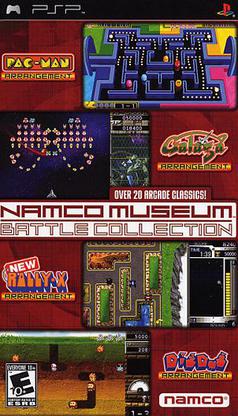
Namco Museum Battle Collection is a 2005 video game compilation developed by Tose and published by Namco for the PlayStation Portable; the first Namco Museum since the original PlayStation series to be developed in Japan. It includes 21 games - four of these are brand-new "arrangement" remakes of older Namco games, while the rest are emulated ports of Namco arcade games from the 1970s and 1980s. These ports include an options menu that allows the player to modify the in-game settings, such as the screen orientation and number of lives. Players can send one-level demos to a friend's console via the "Game Sharing" option in the main menu.

Namco Classic Collection Vol. 1 is a 1995 arcade game compilation developed and published by Namco. It includes three of the company's most well-known games from the early 1980s — Galaga (1981), Xevious (1983), and Mappy (1983) — alongside brand-new "Arrangement" remakes of these games that have updated gameplay, visuals, and sounds. The arcade originals are also modified slightly to end after a certain number of rounds. Super Xevious (1984) is also playable. It ran on the Namco ND-1 arcade system, being one of the first games to utilize it.
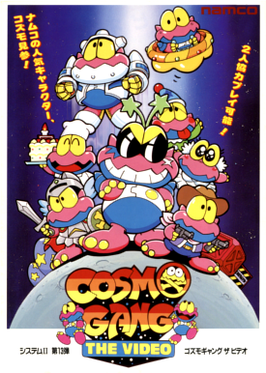
Cosmo Gang the Video is a 1992 fixed shooter arcade game developed and published by Namco. A home conversion for the Super Famicom was released the same year. Controlling the Hyper Beat starship, the player is tasked with ridding the galaxy of the Cosmo Gang, a race of aliens that cause mischief across Earth. Gameplay involves shooting enemies and avoiding projectiles. Power-up items can be collected to grant the player additional abilities. It ran on the Namco System 2 arcade board.

Galaga Legions is a 2008 twin-stick shooter video game developed and released by Namco Bandai Games for the Xbox 360. It is the twelfth game in the Galaxian series, and the third developed for home platforms. The player controls a starship, the AEf-7 "Blowneedle", in its efforts to wipe out the Galaga armada. The objective of the game is to clear each of the five stages as quick as possible. Stages have a heavy emphasis on puzzle solving and chain reactions, which are necessary to clear out enemy formations. The Blowneedle has a pair of satellites at its disposal, and can place them anywhere on the screen to fend off enemies.
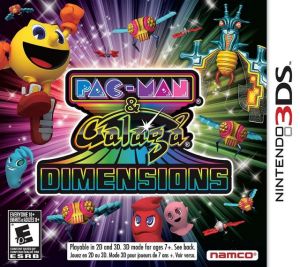
Pac-Man & Galaga Dimensions is a 2011 video game compilation developed and published for the Nintendo 3DS by Namco Bandai Games. It contains six games from the company's Pac-Man and Galaxian franchises—Pac-Man (1980), Galaga (1981), Pac-Man Championship Edition (2007), Galaga Legions (2008), Pac-Man Tilt, and Galaga 3D Impact, the last two being unique games created exclusively for this collection. The collection also includes achievements, online leaderboards, and a trailer for the Pac-Man and the Ghostly Adventures television series.

Galaga Legions DX is a 2011 twin-stick shooter video game developed and published by Namco Bandai Games for the Xbox 360 and PlayStation 3. It is the sequel to Galaga Legions (2008), and is the fourteenth entry in the Galaxian series. The player controls the AEf-7 "Blowneedle" starship in its efforts to wipe out the Galaga forces before they destroy all of mankind. The objective is to clear each of the game's nine stages in the quickest time possible by destroying waves of enemies. The Blowneedle has a pair of satellites that can be pointed at enemies to shoot them down. New additions have been made to the core gameplay, such as a "slowdown" effect when the player is about to collide with an enemy.
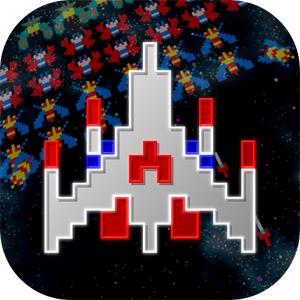
Galaga Remix is an iOS game based on Galaga released in 2009 by Namco Bandai games. It is a compilation title featuring the 1981 arcade shooter Galaga and the Namco Museum Battle Collection version of Galaga Arrangement, though the game is titled Galaga Remix. The games play identical to their original counterparts, with controls being adapted for touch screens, however the compilation lacks the 2-player modes from the original games.
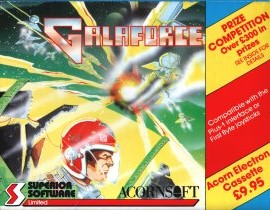
Galaforce is a fixed shooter video game for the BBC Micro and Acorn Electron, written by Kevin Edwards and published by Superior Software in 1986. It spawned a sequel, Galaforce 2 (1988), and later, Galaforce Worlds (2003).

Galaga '91 is a 1991 fixed shooter video game developed and published by Namco for the Game Gear. It was published by Sega in Europe and renamed Galaga 2. The first portable installment in the Galaxian series, players control a lone starfighter in its mission to eradicate the hostile Galaga forces before they take over Earth. Gameplay revolves around shooting down formations of enemies and avoiding their projectiles.















